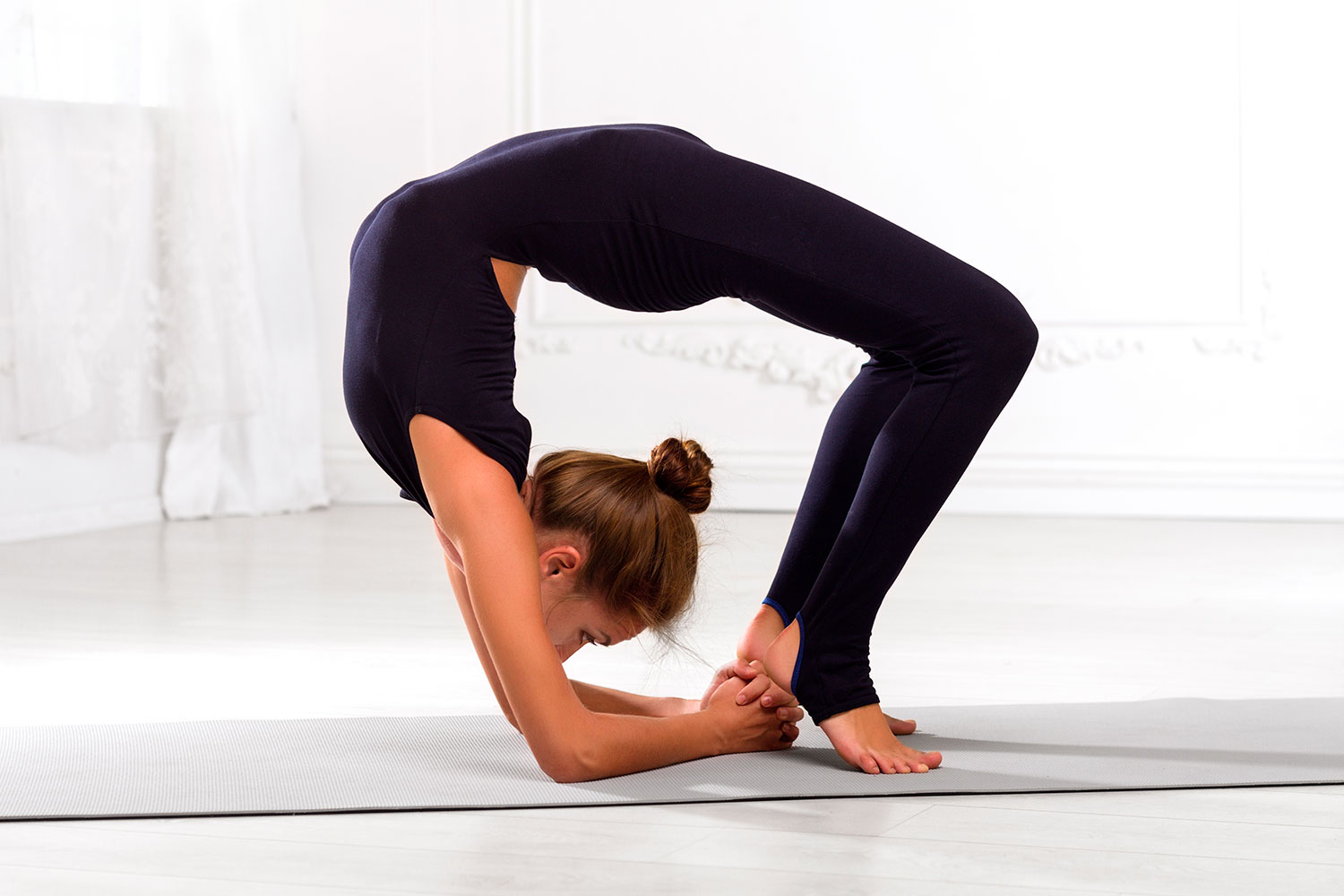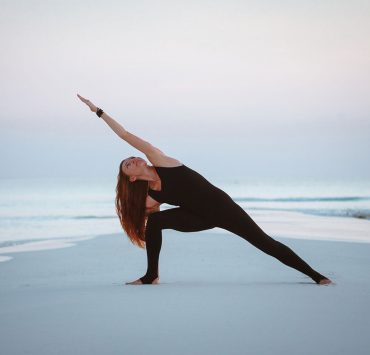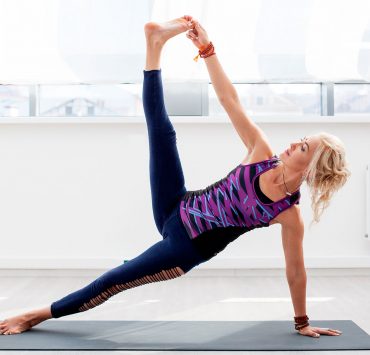
Yoga, meditation, and spirituality are at the top of the…
If you’re inflexible, going to a yoga class and watching people effortlessly move into seemingly impossible positions can be discouraging and intimidating. However, it’s important to remember that anyone can practice yoga and benefit from doing asanas, regardless of how flexible they are. These poses will help you get a well-rounded practice—even if you can’t touch your toes.
If you need to open up your hips:
Sucirandhrasana — Eye of the Needle Pose

Eye of the Needle Pose, or Sucirandhrasana, helps you to gently open up one hip at a time.
Instructions:
Begin lying on your back with your knees bent and soles of your feet on the floor. Place your left ankle over your right thigh underneath your knee, so that your ankle bone is just past the leg. Be sure that your left foot remains flexed.
Clasp your hands around the back of your right leg, and on an exhale, pull your knee in towards your chest. Ensure that your head and shoulders remain relaxed and on the ground.
As you are pulling your right leg towards you, gently push your left knee away from your body to create more of a stretch in your hip.
Hold the position for 30 seconds, and release back down to the floor. Repeat on the opposite side.
Baddha Konasana — Bound Angle Pose

Bound Angle Pose, or Baddha Konasana, is excellent for opening up your hips. It also stretches your groin muscles and inner thighs.
Instructions:
Start seated, with your legs straight out in front of you. On an exhale, bend your knees and bring your feet towards you. Place the soles of your feet together in front of your pelvis, letting the outside edges rest on the mat. Bring them as close to your pelvis as is comfortable.
Allow your knees to drop to either side. They likely will not be able to touch the ground—let them hang in space if that is what is accessible, and resist the urge to push them down. Grab hold of your feet.
Breathe through this posture, ensuring that your spine remains elongated and shoulders relaxed. Hold for about a minute, and then release back to a comfortable seated position.
Anjaneyasana — Low Lunge Twist Pose

By adding a gentle twist to a basic Low Lunge, or Anjaneyasana, you are able to get a deeper stretch in the hips, while also stretching your thighs and back.
Instructions:
Begin in Downward Facing Dog. On an inhale, sweep your right leg up behind you, and on your next exhale, step it forward between your hands. Bring the left knee down to the ground. If necessary, slide it back so you feel more of a stretch in the quads. Your back foot should be untucked.
Ensure that your right knee is stacked over the ankle. On an inhale, twist over to the right, with your left hand remaining on the ground in line with your right foot, and right hand reaching up above you. If necessary, add a block underneath your left hand the bring the ground closer to you.
Remain here for 30 seconds, with your gaze to the right or up to your hand. Release back down into Downward Dog, and repeat on the other side.
Supta Matsyendrasana — Supine Twist Pose

A Supine Twist, or Supta Matsyendrasana, gently massages and stretches your hips, making it a perfect pose if you have inflexibility or tension in that area.
Instructions:
Begin laying down, with your arms extended horizontally. Bend your knees and place the soles of your feet on the ground, close to your glutes.
Keeping your legs together and bent, swing them to the left side towards the ground, with your right leg on top of the left. Turn your head to the opposite side, letting your gaze fall towards your right hand. After holding for a minute or longer, return your gaze and knees to the center, and repeat on the opposite side.
In this twist, you may feel your opposite shoulder wanting to lift, so be mindful of keeping it grounded and away from your ears.
If your shoulders, chest, and back are tight:
Gomukhasana — Cow Face Pose Arms Pose

The arm position in Cow Face Pose, or Gomukhasana, provides a deep stretch along the shoulders, neck, arms, and chest. Using a strap is an excellent option for inflexible people to make the pose accessible.
Instructions:
Start in a seated position, either on your knees or with your legs crossed. Bend your right arm behind your back, so that your hand is between your shoulder blades. With a strap in your hand, raise your left arm above your head, and bend your elbow so that your hand is behind your back.
Grab hold of the strap with you right hand, so that there is tension between your hands on the strap. Hold the pose for about 30 seconds to a minute, being mindful that you are keeping your spine straight and breathing deeply. When you are done, release and repeat on the other side. Both sides can be different, so you may find that you only need the strap on one side.
Bhujangasana — Cobra Pose

Cobra Pose, or Bhujangasana, is a gentle backbend that works to open up the shoulders, back, and chest.
Instructions:
Start lying on your stomach, with your legs together. Bring your hands up towards your shoulders, placing your palms firmly into the mat and your elbows close to your sides.
On an inhale, lift your head and chest, without putting much weight into your palms. Ensure your legs are active and tops of your toes are pressing into the mat. Hold for a couple breaths, and then release back down. Repeat the movement a few times, potentially working towards bending further back each time.
Parsva Balasana — Thread the Needle Pose

Thread the Needle, or Parsva Balasana, is a moderate spinal twist that stretches the shoulders and upper back while releasing tension.
Instructions:
Start in a table top position, with your palms and knees on the ground. Your wrists should be aligned directly under your shoulders, and your knees under your hips. Bring your head in a neutral position, with your gaze downwards.
On an exhale, lift the weight off your right hand and slide your right arm underneath your left arm, with your palm facing up. Your right shoulder should rest down on your mat, along with your right ear, with your gaze now facing left.
Your left arm can be bent or extended out in front of you, and your hips should remain raised. Bring awareness to your shoulders, neck, and lower back, and let go of any tension as you breathe through this pose.
Hold for 30 seconds. To release, bring your left hand back in line with your head if you extended it. Slowly push through your palm, return to table top, and repeat on the other side.
Uttanasana — Forward Fold with Modified Chest Expansion Pose

A Forward Fold, or Uttanasana, uses your own body weight to release tension in the spine. By adding a chest expansion, you are able to get a deeper stretch in the shoulders and upper back. You can use a strap to make the chest expansion more accessible.
Instructions:
Start standing with your feet hips-width distance apart, and hinge forward at your hips. Bring your hands to the ground or a block, and bend your knees as much as needed.
Release any tension in your neck, allowing your gaze to relax behind you, and stay in this pose for a few breaths.
To move into the chest expansion, remain folded and bring your arms behind your back, with your hands at your lower back. Clasp your hands together, or use a strap. Slowly bring your hands forward, towards your head. Don’t force your arms beyond your limits.
Ensure your head remains heavy and relaxed, and that your spine is elongated. Hold the position for about 30 seconds to a minute, and slowly roll up to get out of the pose, releasing your hands at the top.
Parivrtta Sukhasana — Easy Seated Twist Pose

Easy Seated Twist, or Parivrtta Sukhasana, gently stretches your back and shoulders, and can prepare you for more intense twists.
Instructions:
Begin seated with your legs crossed. Inhale and elongate your spine. On an exhale, twist your torso over to the right. Place your right hand behind you, and your left hand on your right leg. Gaze over your right shoulder, and continue to lengthen through your spine.
Hold for 30 seconds, and return to center on an exhale. Repeat on the opposite side.
If your legs could use a stretch:
Adho Mukha Svanasana — Modified Downward Facing Dog Pose (Half Dog with Wall or Chair Option)

Downward Facing Dog, or Adho Mukha Svanasana, allows you to get a deep stretch in your calves and hamstrings. By using a chair or wall for support, you can modify the intensity of the stretch.
Instructions:
Start standing a few feet from the wall or back of a chair. Bend forward at your hips, and put your weight into your hands on the wall/chair. Slowly walk your feet backwards and straighten your arms. Bring your ears in line with your shoulders with your gaze down to the ground.
If you are using the chair and would like a deeper stretch, turn it around and place your hands on the seat. Once you’ve settled into stillness, remain in the pose for 30 seconds to a minute, and walk back forward to release.
Anjaneyasana — Low Crescent Lunge Pose

A Low Lunge, or Anjaneyasana, is great for stretching your quadriceps, hamstrings, glutes, and knees,
Instructions:
Start by kneeling on one knee, with your right leg in front and left leg behind you. Place your hands on the ground on either side of your right foot, using blocks if necessary. Extend your left leg back, with your knee on the ground and the tops of your toes against the mat.
If this is enough of a stretch, you can stay here. If you’d like to go further, engage your core and lift your torso, sweeping your arms over your head. Draw your tailbone down and elongate through your spine. Remain in the pose for approximately 30 seconds, and then repeat on the opposite side.
Supta Padangusthasana — Modified Reclining Hand to Big Toe Pose

Reclining Hand to Big Toe Pose, or Supta Padangusthasana, allows you to stretch your hamstrings and quadriceps. You can modify by using a strap to make the stretch accessible.
Instructions:
Lie on the floor on your back, with your legs extended. On an exhale, bend one knee and bring it into your chest. Ensure that the opposite leg remains active by flexing the foot and extending through the heel.
Loop a strap around the arch of the foot of your bent leg, and place each strap end in both hands. As you inhale, straighten the leg up. Once the leg is extended, adjust your hands on the strap so your arms remain straight, but keep your shoulders on the ground.
If you feel you can go further, you can deepen the stretch by bringing your foot slightly towards your head. Remember to keep the grounded leg and foot active by extending through the heel. After holding the pose for about a minute, release and repeat with the other leg.
Paschimottanasana — Modified Seated Forward Fold Pose

Seated Forward Fold, or Paschimottanasana, is a simple posture that provides a stretch to the back of the legs. It can be modified with a strap, block/blanket, or both.
Instructions:
Begin seated (on a block or blanket if you’d like) with your legs out straight in front of you. Have a strap next to you in case you need it.
Be sure that your spine is elongated and gaze forward. On an inhale, raise your arms above your head. On an exhale, bend at the hips and begin to reach your arms and torso forward.
You can place your hands wherever is accessible, or you can grab for your strap. If using a strap, bend your legs, place the strap along the arches of your feet, grab either side of the strap, and then begin to re-straighten your legs.
As you inhale, elongate through your spine, and as you exhale, drive your chest closer to your toes. Stay in this pose for 30 seconds or longer, and bring your torso back up to release.
Don’t let images of bendy yogis scare you away from yoga. Thankfully, there are a variety of poses that don’t require extreme flexibility, as well as options for modification for more challenging poses. Yoga is accessible for anyone, so try these poses and see where your practice takes you!
What's Your Reaction?
Yoga, meditation, and spirituality are at the top of the list for writer and former nutritionist Amanda Carter. This devoted practitioner enjoys writing about health and wellness just as much as she enjoys living it.














